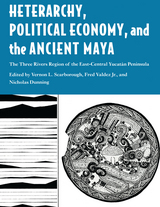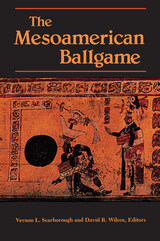2 books about Scarborough, Vernon L.

Heterarchy, Political Economy, and the Ancient Maya
The Three Rivers Region of the East-Central Yucatán Peninsula
Edited by Vernon L. Scarborough, Fred Valdez Jr., and Nicholas Dunning
University of Arizona Press, 2003
The ancient Maya of the southern Yucatán peninsula remain a mystery to many scholars attempting to explain early complex societies. Their dispersed settlement patterns and land-use techniques suggest a decentralized and less coordinated use of resources than is seen in other regions. Yet the Maya managed a complex political economy based on structured landscaping, and over several generations they significantly altered their environment. In recent years the Three Rivers region of Belize and Guatemala has been the site of some of the most intensive archaeological research in the Maya lowlands, providing a wealth of regional data. This volume brings together articles reporting on findings and interpretations of the Programme for Belize Archaeological Project that range over a 10- to 12-year period and that shed new light on how ecology, economy, and political order developed in the ancient past. The contributors explore the applicability of heterarchical models to the Three Rivers region, emphasizing the role of economic interdependency and political cooperation in the development of ancient Maya statecraft. As their findings reflect, this region appears to support a model of resource-specialized communities that affected the region's political and economic development and complexity from the Preclassic through the Late Classic periods. The articles explore the levels of interdependency among the large sites in the region and present a variety of data that emphasize both the engineered landscape and the complex agricultural signatures and ecological indicators left by the Maya. This geographic region captures in microcosm both ecological and cultural differences found in the greater Maya Lowlands. The heterarchical model presented here regarding resource-specialized communities and the interpretations of regional diversity in this area represent a breakthrough in research for the region and will prompt new debate in Maya studies.
[more]

The Mesoamerican Ballgame
Edited by Vernon L. Scarborough and David R. Wilcox
University of Arizona Press, 1991
The Precolumbian ballgame, played on a masonry court, has long intrigued scholars because of the magnificence of its archaeological remains. From its lowland Maya origins it spread throughout the Aztec empire, where the game was so popular that sixteen thousand rubber balls were imported annually into Tenochtitlan. It endured for two thousand years, spreading as far as to what is now southern Arizona. This new collection of essays brings together research from field archaeology, mythology, and Maya hieroglyphic studies to illuminate this important yet puzzling aspect of Native American culture. The authors demonstrate that the game was more than a spectator sport; serving social, political, mythological, and cosmological functions, it celebrated both fertility and the afterlife, war and peace, and became an evolving institution functioning in part to resolve conflict within and between groups. The contributors provide complete coverage of the archaeological, sociopolitical, iconographic, and ideological aspects of the game, and offer new information on the distribution of ballcourts, new interpretations of mural art, and newly perceived relations of the game with material in the Popol Vuh. With its scholarly attention to a subject that will fascinate even general readers, The Mesoamerican Ballgame is a major contribution to the study of the mental life and outlook of New World peoples.
[more]
READERS
Browse our collection.
PUBLISHERS
See BiblioVault's publisher services.
STUDENT SERVICES
Files for college accessibility offices.
UChicago Accessibility Resources
home | accessibility | search | about | contact us
BiblioVault ® 2001 - 2024
The University of Chicago Press









